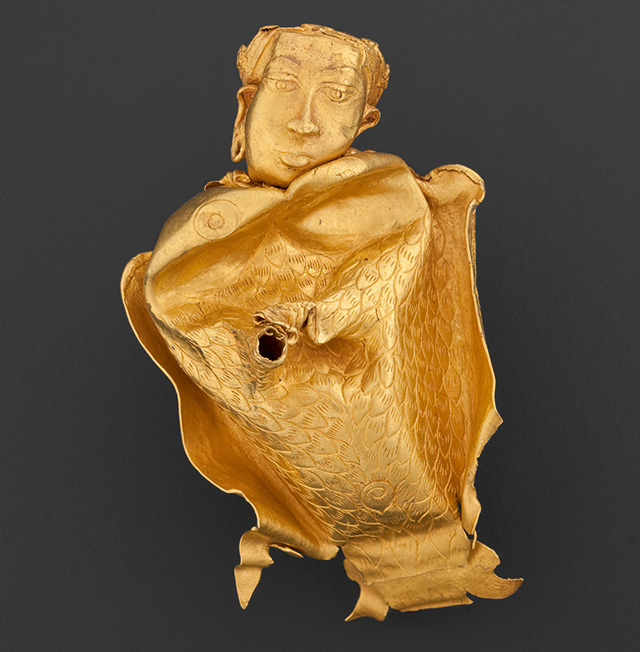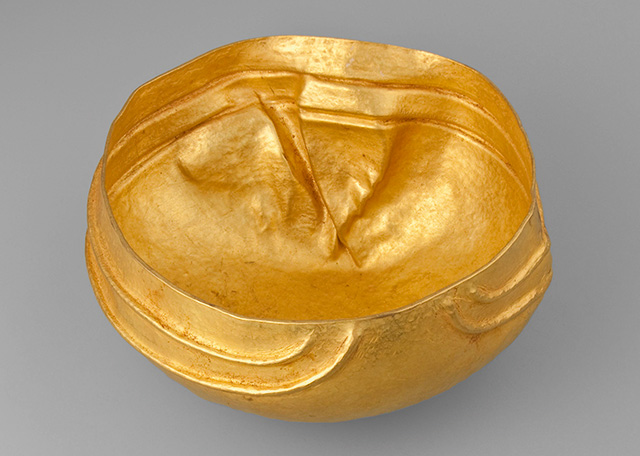A Golden Discovery in the Philippines

Vessel in the form of a kinnari. Surigao Treasure, Surigao del Sur province. Ca. 10th–13th century. Gold. H. 4 ¾ x W. 2 15/16 in. (12 x 7.5 cm). Ayala Museum, 81.5189. Photography by Neal Oshima; Image courtesy of Ayala Museum. An object uncovered by Berto Morales in 1981.

Asia Society Museum’s exhibition Philippine Gold: Treasures of Forgotten Kingdoms, which runs from September 11, 2015, to January 3, 2016, in New York, features recently discovered gold artifacts from little known Philippine cultures that flourished between the 10th and 13th centuries. Learn more
When Filipino worker Berto Morales was digging on a government irrigation project in 1981, he literally struck gold. But what he found that day was worth more than its weight—he had uncovered evidence of a lost civilization.
On Friday, Asia Society New York unveiled its exhibition Philippine Gold: Treasures of Forgotten Kingdoms, displaying more than 100 gold artifacts on loan from the Ayala Museum and the Central Bank of the Philippines in Manila. Most objects trace back to the Kingdom of Butuan — a still scarcely understood civilization centered on the island of Mindanao that rose to prominence in the 10th century before mysteriously declining in the 13th. But it took more than seven centuries for the objects to be found, and once they were, they wouldn’t be seen in the West for another several decades.
Gold has always factored into the history of the Philippines, a country still estimated to have as much as $1 trillion worth of untapped deposits beneath its surface. And despite what little is known about Butuan some aspects of its society clearly revolved around the precious metal.
Many artifacts were first unearthed in the 1970s during the construction of a network of drainage canals. Among them were ceramics from around Southeast Asia and China, as well as boats that were apparently used as trade vessels. These details were corroborated by records from China’s Song Dynasty, whose officials had contact with Butuan from the early 11th century. In 1011, a flamboyant Butuan ambassador reportedly even presented China’s emperor with an engraved gold tablet, sparking interest within China about the kingdom. Evidence shows that an educated and wealthy seafaring civilization existed in the Philippines centuries before explorer Ferdinand Magellan arrived in 1521 and kicked off the Spanish colonial period.
However, it was on that construction site on the southern island of Mindanao in 1981 that the most valuable Butuan cache would be found, bringing ancient Philippine treasures into contact with the modern world.
When Berto Morales was digging with his heavy machinery scraper, a coworker warned him that there was something hard and shiny on the ground that could damage the equipment. Realizing that it could be something valuable, Morales shooed the coworker away and pulled up the obstruction: a gold bowl. As he continued digging, he found gold bracelets, vessels, necklaces, and other ornaments. By the end of the day he had an armful of artifacts.

Bowl. Surigao Treasure, Surigao del Sur province. Ca. 10th–13th century. Gold. H. 3 5/8 x Diam. 6 11/16 in. (9.2 x 17 cm). Ayala Museum, 81.5179. Photography by Neal Oshima; Image courtesy of Ayala Museum. An object uncovered by Berto Morales in 1981.
Morales quietly took the items home in a rice sack and covered them with bananas. An uneducated laborer, he wasn’t sure how to monetize his incredible find. So he took it to his parish priest, trusting that it would be safe in his hands. It was a move he would regret.
As buyers were being found, word got out about the discovery. Pothunters descended on the construction site and were quickly followed by opportunists. “It’s very unfortunate that the military went there, not to protect, but to find gold for themselves in the guise of protecting it,” said Surigao Island Provincial Administrator Johnny Pimentel in a 2008 documentary.
Morales himself soon became a target. At one point his family was kidnapped and sold back to him for ransom. This prompted him to flee the island and change his name. When he returned years later, the parish priest, now living in a nice new house, informed him that the remaining items he had left were gone — and so was the money.
The objects found by Morales and others in the area were distributed in several directions through various unsavory middlemen.
Fortunately, after the objects spread out among various pothunters and dealers, they would often find their way back together among a very small pool of buyers. Many ended up at the Central Bank, which at the time was led by Governor Jaime Laya, an avid art collector who appreciated the value of the artifacts. Many were also bought by Cecilia Locsin and her husband Leandro Locsin, an architect and fellow avid collector. If not for these buyers, much of the cache would have likely been melted down and sold simply for the market value of the gold — a fate that has befallen many ancient Philippine treasures.

Sash or caste cord. Surigao Treasure, Surigao del Sur province. Ca. 10th–13th century. Gold. L. 59 1/16 in. (150 cm); Cross section H. 1 1/16 x W. 15/16 in. (2.7 x 2.4 cm). Ayala Museum, 81.5186. Photography by Neal Oshima; Image courtesy of Ayala Museum. An object uncovered by Berto Morales in 1981.
Cecilia Locsin, herself an archaeologist, spent much of her time trying to unravel the stories the Butuan objects had to tell. It was Locsin’s hope to someday have the gold put on display in a museum and eventually travel overseas to give the world a glimpse of the Philippines’ rich cultural heritage.
Finally, in 2008 — 27 years after its discovery — the Butuan gold went on display at the Ayala Museum, protected by an elite security force. And this year, Asia Society was able to bring the gold outside of the Philippines for the first time to New York. “We knew this exhibition was something that needed to happen quite quickly because it was a small window of opportunity,” said Asia Society John H. Foster Senior Curator for Traditional Asian Art Adriana Proser. “The material is spectacular. When I saw it I thought, ‘this doesn’t just have implications for the Philippines, it has implications for the rest of Asia’ because clearly the nature of the objects and the craftsmanship show that there were things going on that we haven’t studied before.”
Florina H. Capistrano-Baker, Consulting Curator of Ayala Museum, explained that the artifacts show a rich sophisticated Philippine culture and trading network that existed and interacted with other civilizations in Asia long before western colonists arrived. “There’s this cultural amnesia — even among Filipinos — where we think of our culture as only beginning during the Spanish period when we were finally civilized and then later educated under the American system,” she said. “Yet there’s this undiscovered substratum that merits greater study that might make us feel more culturally related to other Southeast Asians.”
Proser added that still very little is known about many of the artifacts and how they were used in Butuan, which makes their journey to America promising, not only in terms of cultural outreach but also in terms of exposing them to study by fresh eyes from different backgrounds and disciplines. “There’s all this fabulous material and we’re just starting to connect the dots,” Proser said. “Part of the appeal of this exhibition is the mystery that surrounds it. Somebody just has to come and unlock it.”

